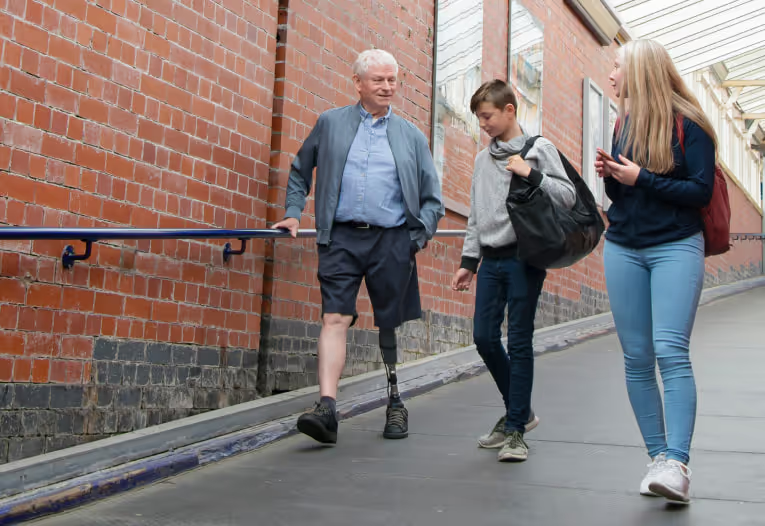Cooking with only one arm can present unique challenges, but it doesn't have to limit your culinary adventures. With the right amputee kitchen aids and a few helpful tips, you can still enjoy cooking and create delicious meals with ease.
At PrimeCare, we understand the importance of independence in the kitchen. This is why we've compiled a comprehensive guide to assist upper-limb amputees in navigating the kitchen confidently and efficiently. Whether you're chopping, stirring, or baking, there are plenty of tools and techniques to make your cooking experience both enjoyable and successful.
Adaptive Cooking Devices
Let’s explore the practical solutions and innovative gadgets designed to streamline cooking tasks for those with limited dexterity or the use of only one hand.
Slicing and Chopping
- Use a food processor, vegetable peeler, or hand chopper for efficient chopping tasks.
- Opt for a rocker knife for smooth cutting motions to reduce the need for sawing actions.
- Utilize a pizza cutter to effortlessly slice through various foods like sandwiches and quesadillas.
- Consider using one-handed scissors for opening packages with ease and battery-operated one-handed can opener, leaving no sharp edges behind.
- Invest in a cutting board equipped with suction cups to prevent slippage so food preparation is safe.
Measurement
- Use vegetable choppers with built-in measurements for easy and precise measuring.
- Use of a turkey baster for accurate measurement of smaller quantities.
- Enhance accessibility by attaching a rubber band to cans and containers for level measuring with dry utensils.
Handling Hot Items

- Safely pull out oven racks with an oven mitt to facilitate easier dish retrieval.
- Opt for smaller sheet pans to reduce weight when removing items from the oven.
- Choose plastic mixing bowls with non-slip bases for lightweight and secure handling.
- Slide hot items onto stable surfaces directly from the microwave to prevent accidents.
- Use high-quality, non-slip oven mitts for a secure grip.
- If you’re cooking on the stovetop, a folding pan holder secures the pan in place and makes stirring food easier.
Storage Solutions
- Select containers with easy-open lids or pull tabs for hassle-free access.
- Prevent slips and spills by using shelf lining to stabilize bowls, plates, or cutting boards during use.
Adaptive Utensils
- Customize utensils with textured or built-up handles for improved grip and control.
- Enhance stability with non-slip mats placed under kitchenware during meal preparation.
- Explore specialized tools such as suction cup plates and pot stabilizers for more convenience.
- Consider electric jar openers and silicone cooking baskets to simplify food preparation tasks.
- Simplify seasoning with electric salt and pepper grinders that provide effortless operation with the push of a button.
- Explore one-handed pouring aids for individuals with limited hand function that offer ease and convenience when pouring liquids.
Cooking Tips for One-Handed Use

You can make the cooking experience that much better with these tips:
- Practice Consistently: Familiarity with the process will make it less daunting over time.
- Take Your Time: Rushing increases the risk of injury or spills, so give yourself plenty of time for meal preparation, cooking, and cleanup.
- Start Simple: Start with one to two-step recipes like premade mixes, gradually advancing as confidence grows.
- Divide Tasks: When cooking with a friend or partner, each tackles different parts of the meal to make cooking more efficient and enjoyable.
- Seek Assistance: Have a trusted companion observe and offer advice for tasks you're less confident in to build your skills and confidence.
- Oven Practice: Practice handling dishes (even without food) in and out of the oven to improve dexterity and confidence, starting with smaller, lighter items.
- Prep Convenience: Opt for pre-measured or pre-cut ingredients to streamline preparation.
- Use Tools Wisely: Tools with suction cups secure items, while electric mixers can shred cooked chicken effortlessly.
- Egg Cracking Technique: Crack an egg with one hand by hitting it against a surface, then use your fingers to separate the halves.
- Extra Servings: Make extra portions of meals and freeze them for later use.
- Organize Ingredients: Gather all ingredients before starting to focus on cooking without interruptions.
- Handy Cleaning: Attach a scrub brush with a suction cup for easier washing of fruits and vegetables.
- Cooking Techniques: Use vegetable steamers or pot inserts to cook without the need to lift heavy pots.
- Oven Preference: Opt for oven or broiler cooking when possible for easier handling of food.
- Disposable Tableware: If you don’t have a dishwasher, consider using disposable paper plates.
- Parchment paper: Use parchment paper on baking sheets for an easy cleanup process.
Embracing Culinary Independence with PrimeCare
We know that for many, spending time in the kitchen is priceless, and this isn’t something you have to give up. Discovering adaptive tools and techniques can revolutionize cooking experiences for individuals with unique needs. PrimeCare empowers individuals with prosthetic devices and offers comprehensive support to navigate the kitchen with confidence. Since 2009, we’ve been empowering individuals to regain mobility and a sense of independence.
Whether you're exploring prosthetic options, our team is here to help you enjoy cooking and enhance your culinary independence. Contact PrimeCare today to embark on a journey towards a more fulfilling kitchen experience.

.svg)
.svg)









